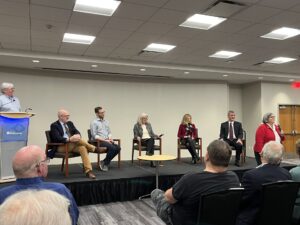Did you ever wonder why so few people read your posts and/or tweets? The use of social media can be an inexact science, and more of an art. But there are a few basic tips that will help. Below is one man’s opinion (not the results of some academic or empirical study) I thought I’d share with followers and friends. My role as an adjunct professor in the Journalism Program at the University at Albany, where I teach courses in public relations writing and crisis communications, forces me to keep abreast of social media trends, so I started writing down my own personal preferences. And so here they are…
“Serial” tweeting — Okay, I know you might be at some important local government meeting or speech where a critical issue is being discussed, but unless you find a way to remind your followers about the subject each time you tweet, I’ll move on. I won’t scroll all the way back to the first of 29 tweets to learn the topic. You have 140 characters; use them well every time. One possible solution is to #hashtag each tweet with a simple topic, using a phrase others are using — not one you just made up.
The “cliffhanger” tweet — “And the best city in the country for young professionals to find jobs is…” And then you have to click the link to find out? Not. Tell me up front it’s Boston, or San Francisco, or Chicago…and then I’ll actually click the link to find out why.
“Click bait” from tweets and Facebook postings — Almost any basic website designer or manager can post a list of 10 best things from top to bottom on one page. If the tweet or post takes me to a page where I see only the first item on a list of 10, forcing me to keep clicking for nine more pages (generating clicks and views for advertisers in the process) my cursor creeps up to the “x” on the upper right and I move on to something more interesting.
My tweet runneth over — Almost every day I see tweets that have obviously run well past 140 characters, resulting in expression of an incomplete thought. I chuckle and move on, especially if the tweet contains a link.
A tweet with a link, without an explanation — This is one of my pet peeves. Someone tweets a link to a website without informing readers what they’ll find once they get there. Given the myriad efforts to relieve all of us of our personal information via phishing and other scams, I keep scrolling downward past this tweet or post.
Video ads — Almost every time I click to a video from a tweet or post, I’m forced to see a commercial first. I hate them and I often whine to colleagues that these are killing the Internet. Still, if I’m really interested in the video topic, I’ll suffer through the pain. Just make sure the ad is as short as possible (a 30-second spot before a 12-second clip of the winning hit in last night’s game? Too much), and the promised video works as well as the paid ad. A lot of times I transition from a flawlessly played ad to a herky jerky video, or one that doesn’t work at all. Test it.
Photos — If you post a photo on Facebook or tweet a link to photo, please give me some information. I’ve long believed that one of the most interesting things social media users can post are photos of people (and maybe dogs). But please identify them. And if you tweet/post a photo of a place or thing, tell me what it is. Don’t sit there waiting breathlessly hoping someone will ask you who or what this is in an effort to generate more comments or replies for you, because I certainly won’t ask. Tell me up front who or what it is, and I’m probably going to “like” or comment, and possibly even share or re-tweet with a complimentary comment.
Politics — I’m all done in this arena. My eyes start to glaze over within milliseconds when I see the non-stop parade of acerbic, accusatory, and mostly unfounded claims in the political space. So, so many Internet trolls have moved into the social media space I wonder if they’ve lost their effectiveness. I’m sure I’m not alone in growing weary over social media giving a new voice to an awful lot of ugliness out there.
On sale! — Social media is just that: a new way for people to interact beyond face-to-face settings, often over great distances and at literally no cost. Don’t turn your personal social media presence into a storefront. If you’re constantly using your personal Facebook posts or Twitter feeds to sell something, and you want people to still be interested in what you have to say, please stop. My friends on social media are my friends. I won’t unfollow or unfriend, but Twitter has given us the new “mute” button and Facebook allows you to unfollow someone but still be a friend. If you want to sell something, create a new Facebook identity that is a storefront, not a personal one masquerading as a shopping mall.
Answer the question! — If you post something interesting and a reader asks a question, answer it in the comments section or by tweeting the answer so we can all see it. It’s like being at a big speech, presentation or press conference. The speaker not only answers the questions for all to hear, but also repeats the question. In social media everyone sees the question, so answer it in the same format.
Grammar school — I regularly teach my students (well, some would say I preach it) not to abandon grammar rules and correct spelling when you post and tweet. Sure, you might use some abbreviations like LMAO, but make sure it’s an abbreviation that everyone knows. Misspelling words and employing poor grammar are sure tickets to diminishing respect in this space, especially if you’re an up-and-coming professional.
Awkward — Another topic I often talk about in class is posting bizarre, embarrassing photos of yourself. Congressmen have actually lost careers over this. Google Anthony Weiner. If you don’t want a future employer, college, or spouse to know you could do keg stands for 10 minutes, don’t post it. I’d argue that you shouldn’t do some of these dumb things in the first place, but that’s beyond the authority of this piece.
#$%&!@#$ — Please don’t swear, for the same reason I listed in the previous item. Not a day goes by when I don’t see someone dropping an F-bomb, in writing. Sure, you might use this out on the back porch or at the bar during alcohol-fueled Red Sox vs. Yankees rants, but would you really say that in front of thousands of eyeballs? Keep it civil.
No place for hate — Even if you’re one of the few who still harbor racist, sexist, homophobic or whatever other strong discriminatory beliefs, please resist posting them. You’ll only get up the next day and realize how stupid you look when you see your posts in black and white. Google Justine Sacco some time and you’ll get my drift.
The survey says I’m Mother Teresa! –This new wave of online polls, where you’re told what famous person you are or what type of person you are after answering a series of questions, got old like four days after the first one was rolled out. I know who I am. My friends know who I am. Sure these poll are kind of cute, but pass them by or at least don’t post the results. After all, you wouldn’t post it if the survey came back and said you were like Charles Manson, right?
Food — You ate at a neat restaurant and you posted a picture of how the food was presented on your plate. There’s nothing really awkward, offensive, or wrong here. It’s just the most boring thing I’ve seen on the Internet since I began surfing it in the late 1990s. When a social media platform comes up with an aroma feature, maybe I’ll go here…maybe.
Selfies — I’m sort of a fan of these, but please keep it to a minimum. If you post dozens and dozens of pictures of yourself I start to worry about you. And if I can tell you’re using one of those selfie sticks that stop roller coasters or just got banned from Disney, I might select the mute or unfollow button.
Length matters — Twitter is self-policing here, but keep those Facebook postings or blog entries somewhere south of 2,000 words. Well, actually they should be a lot shorter. It’s a fact: Shorter blogs and Facebook posts get read much more often. War and Peace has been done. Move on.
BREAKING NEWS! — This is a new, disturbing trend. Not only are media organizations over-using this phrase, but some non-media social media players are using it in a vain effort to capture eyeballs. As it was when the local 11 p.m. news teams overused this term into oblivion decades ago, this is used way too much now. This is especially annoying when it involves news about a celebrity. You know who the regular offenders are.
ICYMI — We all know what that means, right? We all have our favorite posts or tweets, but don’t repeat it 10 times to try and hit readers at different times during the day. I’ve actually seen a tweet repeated 14 times. Really? Is it that interesting?
What a crowd! — You just posted or tweeted pictures of reporters, photographers, and videographers showing up at your event. The assembled masses of journalists appear poised to hear what you or your organizers have to say, adding gravitas to your event. I’m not impressed and it looks like you’re over-reaching for attention. Post what was actually said or done. That’s a lot more interesting.
——
I think that’s enough for now. If you have any other favorites, pass them along to me at markmarchand56@gmail.com. If you disagree, please do so diplomatically and I’ll actually read your note. I remind you that this is not at all an empirical analysis of social media use. It’s one person’s opinion. Until the next time….Mark Marchand [contact-form][contact-field label=’Name’ type=’name’ required=’1’/][contact-field label=’Email’ type=’email’ required=’1’/][contact-field label=’Website’ type=’url’/][contact-field label=’Comment’ type=’textarea’ required=’1’/][/contact-form]



